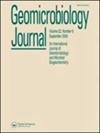微生物诱导碳酸钙沉淀固化风成砂的力学性能
IF 2.2
4区 环境科学与生态学
Q3 ENVIRONMENTAL SCIENCES
引用次数: 0
摘要
摘要始新世沙广泛分布于沙漠地区,在风和热的共同作用下,很容易引发沙尘暴。本文通过微生物诱导碳酸钙沉淀(MICP)进行风积砂固化试验,探讨了MICP在防尘固沙领域的应用前景。基于响应面法和正交实验进行了细菌生长试验和MICP矿化反应试验。基于风积砂固化试验,分析了胶结数和干密度对固化风积砂渗透性和强度特性以及生成的CaCO3含量的影响。结果表明,细菌在35℃时生长最好 °C,pH值为9,摇动频率为170 rpm。脲酶活性和细菌浓度均随温度和pH的升高而升高,但随着摇动速度的加快,脲酶活性呈先升后降的趋势。MICP矿化的最佳条件是细菌浓度OD600=1.5,固结液浓度为1 mol/L,反应时间为16 h、 pH为9,温度为25 °C。固化风积砂的渗透系数随干密度和胶结次数的增加而降低,CaCO3含量随胶结次数的增多而增加。随着胶结次数的增加,风积砂的无侧限抗压强度(UCS)在稳定之前先上升,然后再次上升。CaCO3含量与UCS呈正相关,相关系数达到0.80。本文章由计算机程序翻译,如有差异,请以英文原文为准。
Mechanical Properties of Eolian Sand Solidified by Microbially Induced Calcium Carbonate Precipitation (MICP)
Abstract Eolian sand is widely distributed in desert areas, and can easily trigger sandstorms under the combined effects of wind and thermal conditions. In this paper, an eolian sand solidification test via microbially induced calcium carbonate (CaCO3) precipitation (MICP) was conducted to explore prospective applications of MICP in the field of dust prevention and sand fixation. A bacterial growth test and a MICP mineralization reaction test were performed based on the response surface method and an orthogonal experiment. Based on eolian sand solidification test, the effects of cementation number and dry density on the permeability and strength characteristics of solidified eolian sand, as well as the content of CaCO3 generated were analyzed. The results showed that the bacteria grew best at a temperature of 35 °C, a pH of 9, and a shaking frequency of 170 rpm. Both urease activity and bacterial concentration increased as the temperature and pH increased but showed a trend of rising before falling as the shaking grew faster. The optimal conditions for MICP mineralization were a bacterial concentration of OD600=1.5, a consolidating fluid concentration of 1 mol/L, a reaction time of 16 h, a pH of 9, and a temperature of 25 °C. The permeability coefficient of solidified eolian sand decreased as the dry density and the number of cementations increased, whereas the CaCO3 content increased with the number of cementations. As the number of cementations increased, the unconfined compressive strength (UCS) of eolian sand initially rose before stabilizing and then increasing again. The CaCO3 content had a positive relationship with UCS, which with the correlation coefficient reached 0.80.
求助全文
通过发布文献求助,成功后即可免费获取论文全文。
去求助
来源期刊

Geomicrobiology Journal
环境科学-地球科学综合
CiteScore
4.80
自引率
8.70%
发文量
70
审稿时长
3.3 months
期刊介绍:
Geomicrobiology Journal is a unified vehicle for research and review articles in geomicrobiology and microbial biogeochemistry. One or two special issues devoted to specific geomicrobiological topics are published each year. General articles deal with microbial transformations of geologically important minerals and elements, including those that occur in marine and freshwater environments, soils, mineral deposits and rock formations, and the environmental biogeochemical impact of these transformations. In this context, the functions of Bacteria and Archaea, yeasts, filamentous fungi, micro-algae, protists, and their viruses as geochemical agents are examined.
Articles may stress the nature of specific geologically important microorganisms and their activities, or the environmental and geological consequences of geomicrobiological activity.
The Journal covers an array of topics such as:
microbial weathering;
microbial roles in the formation and degradation of specific minerals;
mineralization of organic matter;
petroleum microbiology;
subsurface microbiology;
biofilm form and function, and other interfacial phenomena of geological importance;
biogeochemical cycling of elements;
isotopic fractionation;
paleomicrobiology.
Applied topics such as bioleaching microbiology, geomicrobiological prospecting, and groundwater pollution microbiology are addressed. New methods and techniques applied in geomicrobiological studies are also considered.
 求助内容:
求助内容: 应助结果提醒方式:
应助结果提醒方式:


